Multiple Patterns of Forest Disturbance and Logging Shape Forest Landscapes in Paragominas, Brazil
Abstract
:1. Introduction
2. State of the Art: Implementing Operational Remote Sensing Indicators to Monitor Logging Activities through Time
3. Materials and Methods
3.1. Study Site
Selection of Forested Plots in Paragominas
3.2. Data Processing
3.2.1. Remote Sensing Images Selection and Calibration
3.2.2. Remote Sensing Steps to Detect the Impacts of Logging
3.3. Development of Indicators of Forest Disturbance through Time Due to Logging
- Maximum intensity of disturbance (%): maximum area of the plots which has been disturbed in one year during the study period (in proportion to the plot’s total area);
- Cumulative disturbance (%): sum of the area disturbed each year during the whole study period (in proportion to the plot’s total area);
- Mean disturbance (%): mean area disturbed over the study period (in proportion to the plot’s total area);
- Frequency of disturbance: how many times the forest cover underwent a disturbance impact of more than 1% of the total plot extent over the study period.
3.4. Statistical Analysis
4. Results
4.1. Distinct Disturbance Patterns in Function of Forest Management Types
4.2. Different Patterns of Forest Disturbance Occurring in Paragominas
- Pattern 1 “Low impacted plots” (dark group, n = 27 plots): These plots are characterized by lower scores for all the disturbance indicators. Over the fifteen year period, the average maximum disturbance was 2.6%, with a cumulative disturbance of 5.8% and a mean disturbance of 0.6%. These kinds of values suggest that these plots have been managed with RIL techniques, producing small canopy openings which are quickly closed.
- Pattern 2 “Moderately impacted plots” (red group, n = 22 plots): These plots have suffered more disturbance than the plots of pattern 1, but they are still characterized by lower mean values than the overall mean. For example, the average maximum of disturbance was only 6.0% and the cumulative disturbance over the fifteen year period was 20.2%. These kinds of values suggest that these plots have been managed with conventional logging techniques.
- Pattern 3 “Intensively impacted plots” (dark blue group, n = 10 plots): These plots are different from the others due to their higher score for the maximum disturbance indictor (average maximum of disturbance of the group was 19.2%). As such, these plots have suffered one intensive timber harvest with high damages in the canopy cover. Due to these damages, the recovery was low, and so the cumulative disturbance over the fifteen year period was high (average cumulative disturbance of the group was 40.2%).
- Pattern 4 “Very frequently degraded plots” (green group, n = 19 plots): These plots are different from the others due to their higher score for the frequency of disturbance indicator. On average, these plots have suffered three exploitations during the fifteen years period. However, the average maximum disturbance was lower than in pattern 3 with 10.8%, but due to the high frequency of disturbance, the cumulative disturbance over the period was higher (45.6%). These kinds of disturbance values shape a pattern of very frequent small to medium disturbances, typical of extractive timber practices for different purposes.
- Pattern 5 “Very intensively degraded plots” (cyan group, n = 3 plots): These plots are different from the others due to their higher score for all the disturbance indicators. On average, they have suffered five impacts during the period, with a cumulative disturbance of 71.2%. These plots have been intensively degraded and regular harvests have occurred to exploit any wood resources, decreasing the forest resilience to surrounding fires.
5. Discussion
6. Conclusions
Acknowledgments
Author Contributions
Conflicts of Interest
References
- Edwards, D.P.; Tobias, J.A.; Sheil, D.; Meijaard, E.; Laurance, W.F. Maintaining ecosystem function and services in logged tropical forests. Trends Ecol. Evol. 2014, 29, 511–520. [Google Scholar] [CrossRef] [PubMed]
- Asner, G.P.; Rudel, T.K.; Aide, T.M.; Defries, R.; Emerson, R. A Contemporary Assessment of Change in Humid Tropical Forests. Conserv. Biol. 2009, 23, 1386–1395. [Google Scholar] [CrossRef] [PubMed]
- Asner, G.P.; Knapp, D.E.; Broadbent, E.N.; Oliveira, P.J.C.; Keller, M.; Silva, J.N. Selective logging in the Brazilian Amazon. Science 2005, 310, 480–482. [Google Scholar] [CrossRef] [PubMed]
- Barlow, J.; Lennox, G.D.; Ferreira, J.; Berenguer, E.; Lees, A.C.; Mac Nally, R.; Thomson, J.R.; Ferraz, S.F.; Louzada, J.; Oliveira, V.H.; et al. Anthropogenic disturbance in tropical forests can double biodiversity loss from deforestation. Nature 2016, 535, 144–147. [Google Scholar] [CrossRef] [PubMed]
- Lewis, S.L.; Edwards, D.P.; Galbraith, D. Increasing human dominance of tropical forests. Science 2015, 349, 827–832. [Google Scholar] [CrossRef] [PubMed]
- Souza, C., Jr.; Siqueira, J.V.; Sales, M.H.; Fonseca, A.V.; Ribeiro, J.G.; Numata, I.; Cochrane, M.A.; Barber, C.P.; Roberts, D.A.; Barlow, J. Ten-Year Landsat Classification of Deforestation and Forest Degradation in the Brazilian Amazon. Remote Sens. 2013, 5, 5493–5513. [Google Scholar] [CrossRef]
- Gibbs, H.K.; Ruesch, A.S.; Achard, F.; Clayton, M.K.; Holmgren, P.; Ramankutty, N.; Foleyl, J.A. Tropical forests were the primary sources of new agricultural land in the 1980s and 1990s. Proc. Natl. Acad. Sci. USA 2010, 107, 16732–16737. [Google Scholar] [CrossRef] [PubMed]
- Putz, F.E.; Zuidema, P.A.; Synnott, T.; Peña-Claros, M.; Pinard, M.A.; Sheil, D.; Vanclay, J.K.; Sist, P.; Gourlet-Fleury, S.; Griscom, B.; et al. Sustaining conservation values in selectively logged tropical forests: The attained and the attainable. Conserv. Lett. 2012, 5, 296–303. [Google Scholar] [CrossRef]
- Bustamante, M.M.C.; Roitman, I.; Aide, T.M.; Alencar, A.; Anderson, L.O.; Aragão, L.; Asner, G.P.; Barlow, J.; Berenguer, E.; Chambers, J.; et al. Toward an integrated monitoring framework to assess the effects of tropical forest degradation and recovery on carbon stocks and biodiversity. Glob. Chang. Biol. 2016, 22, 92–109. [Google Scholar] [CrossRef] [PubMed]
- Richardson, V.A.; Peres, C.A. Temporal Decay in Timber Species Composition and Value in Amazonian Logging Concessions. PLoS ONE 2016, 11, e0159035. [Google Scholar] [CrossRef] [PubMed]
- Gerwing, J.J. Degradation of forests through logging and fire in the eastern Brazilian Amazon. For. Ecol. Manag. 2002, 157, 131–141. [Google Scholar] [CrossRef]
- Pacheco, P.; Mejía, E.; Cano, W.; de Jong, W. Smallholder Forestry in the Western Amazon: Outcomes from Forest Reforms and Emerging Policy Perspectives. Forests 2016, 7, 193. [Google Scholar] [CrossRef]
- Piketty, M.-G.; Drigo, I.; Sablayrolles, P.; de Aquino, E.A.; Pena, D.; Sist, P. Annual Cash Income from Community Forest Management in the Brazilian Amazon: Challenges for the Future. Forests 2015, 6, 4228–4244. [Google Scholar] [CrossRef]
- Sist, P.; Rutishauser, E.; Peña-Claros, M.; Shenkin, A.; Herault, B.; Blanc, L.; Baraloto, C.; Baya, F.; Benedet, F.; Da Silva, K.E.; et al. The Tropical managed Forests Observatory: A research network addressing the future of tropical logged forests. Appl. Veg. Sci. 2015, 18, 171–174. [Google Scholar] [CrossRef]
- Rutishauser, E.; Hérault, B.; Baraloto, C.; Blanc, L.; Descroix, L.; Sotta, E.D.; Ferreira, J.; Kanashiro, M.; Mazzei, L.; d’Oliveira, M.V.N.; et al. Rapid tree carbon stock recovery in managed Amazonian forests. Curr. Biol. 2015, 25, 787–788. [Google Scholar] [CrossRef] [PubMed]
- Asner, G.P.; Knapp, D.E.; Balaji, A.; Páez-Acosta, G. Automated mapping of tropical deforestation and forest degradation: CLASlite. J. Appl. Remote Sens. 2009, 3, 033543. [Google Scholar] [CrossRef]
- Asner, G.P.; Broadbent, E.N.; Oliveira, P.J.C.; Keller, M.; Knapp, D.E.; Silva, J.N.M. Condition and fate of logged forests in the Brazilian Amazon. Proc. Natl. Acad. Sci. USA 2006, 103, 12947–12950. [Google Scholar] [CrossRef] [PubMed]
- Bourbier, L.; Cornu, G.; Pennec, A.; Brognoli, C.; Gond, V. Large-scale estimation of forest canopy opening using remote sensing in Central Africa. Bois For. Trop. 2013, 1, 3–9. [Google Scholar]
- French Space Agency (CNES). Orfeo ToolBox, Open Source Processing of Remote Sensing Images. Available online: https://www.orfeo-toolbox.org (accessed on 1 February 2016).
- Souza, C. Mapping forest degradation in the Eastern Amazon from SPOT 4 through spectral mixture models. Remote Sens. Environ. 2003, 87, 494–506. [Google Scholar] [CrossRef]
- Gond, V.; Guitet, S. Elaboration d’un diagnostic post-exploitation par télédétection spatiale pour la gestion des forets de Guyane. Bois For. Trop. 2009, 299, 6–9. [Google Scholar]
- Pithon, S.; Jubelin, G.; Guitet, S.; Gond, V. A statistical method for detecting logging-related canopy gaps using high-resolution optical remote sensing. Int. J. Remote Sens. 2013, 34, 700–711. [Google Scholar] [CrossRef]
- Asner, G.P.; Powell, G.V.N.; Mascaro, J.; Knapp, D.E.; Clark, J.K.; Jacobson, J.; Kennedy-Bowdoina, T.; Balajia, A.; Paez-Acostaa, G.; Victoriac, E.; et al. High-resolution forest carbon stocks and emissions in the Amazon. Proc. Natl. Acad. Sci. USA 2010, 107, 16738–16742. [Google Scholar] [CrossRef] [PubMed]
- Leisher, C.; Touval, J.; Hess, S.M.; Boucher, T.M.; Reymondin, L. Land and Forest Degradation inside Protected Areas in Latin America. Diversity 2013, 5, 779–795. [Google Scholar] [CrossRef]
- International Center for Tropical Agricuture. Terra-I, an Eye on Habitat Change. Available online: http://www.terra-i.org (accessed on 8 September 2016).
- Diniz, C.G.; de Almeida Souza, A.A.; Santos, D.C.; Dias, M.C.; da Luz, N.C.; de Moraes, D.R.V.; Maia, J.S.; Gomes, A.R.; da Silva Narvaes, I.; Valeriano, D.M.; et al. DETER-B: The New Amazon near Real-Time Deforestation Detection System. IEEE J. Sel. Top. Appl. Earth Obs. Remote Sens. 2015, 8, 3619–3628. [Google Scholar] [CrossRef]
- World Resources Institute. Global Forest Watch: Monitoring Forests in Near Real Time. Available online: http://www.globalforestwatch.org (accessed on 8 September 2016).
- Logging Roads. Available online: http://loggingroads.org/ (accessed on 8 September 2016).
- Tritsch, I.; Le Tourneau, F.-M. Population densities and deforestation in the Brazilian Amazon: New insights on the current human settlement patterns. Appl. Geogr. 2016, 76, 163–172. [Google Scholar] [CrossRef]
- Guimarães, J.; Veríssimo, A.; Amaral, P.; Demachki, A. Municípios Verdes: Caminhos Para a Sustentabilidade, 2nd ed.; Imazon: Belém, Brazil, 2011. [Google Scholar]
- Viana, C.; Coudel, E.; Barlow, J.; Ferreira, J.; Gardner, T.; Parry, L. From Red to Green: Achieving an Environmental Pact at the Municipal Level in Paragominas (Pará, Brazilian Amazon). Available online: http://agritrop-prod.cirad.fr/567220/1/document_567220.pdf (accessed on 10 July 2016).
- Sist, P.; Ferreira, F.N. Sustainability of reduced-impact logging in the Eastern Amazon. For. Ecol. Manag. 2007, 243, 199–209. [Google Scholar] [CrossRef]
- Tropical Managed Forests Observatory. Available online: http://www.tmfo.org/ (accessed on 2 October 2016).
- United States Geological Survey. GLOVIS: The USGS Global Visualization Viewer. Available online: https://www.glovis.usgs.org (accessed on 9 September 2015).
- Instituto Nacional de Pesquisas Espaciais (INPE). Projeto PRODES: Monitoramento da Floresta Amazônica Brasileira por Satélite. Available online: http://www.obt.inpe.br/prodes/index.php (accessed on 10 February 2016).
- Souza, C.M.; Roberts, D.A.; Cochrane, M.A. Combining spectral and spatial information to map canopy damage from selective logging and forest fires. Remote Sens. Environ. 2005, 98, 329–343. [Google Scholar] [CrossRef]
- Ahmed, S.E.; Ewers, R.M. Spatial Pattern of Standing Timber Value across the Brazilian Amazon. PLoS ONE 2012, 7, e36099. [Google Scholar] [CrossRef] [PubMed]
- Matricardi, E.A.T.; Skole, D.L.; Pedlowski, M.A.; Chomentowski, W. Assessment of forest disturbances by selective logging and forest fires in the Brazilian Amazon using Landsat data. Int. J. Remote Sens. 2013, 34, 1057–1086. [Google Scholar] [CrossRef]
- Ghazoul, J.; Burivalova, Z.; Garcia-Ulloa, J.; King, L. Conceptualizing Forest Degradation. Trends Ecol. Evol. 2015, 30, 622–632. [Google Scholar] [CrossRef] [PubMed]
- Putz, F.E.; Sist, P.; Fredericksen, T.; Dykstra, D. Reduced-impact logging: Challenges and opportunities. For. Ecol. Manag. 2008, 256, 1427–1433. [Google Scholar] [CrossRef]
- Chaudhary, A.; Burivalova, Z.; Koh, L.P.; Hellweg, S. Impact of Forest Management on Species Richness: Global Meta-Analysis and Economic Trade-Offs. Sci. Rep. 2016, 6, 23954. [Google Scholar] [CrossRef] [PubMed]
- Kleinschroth, F.; Healey, J.R.; Sist, P.; Mortier, F.; Gourlet-Fleury, S. How persistent are the impacts of logging roads on Central African forest vegetation? J. Appl. Ecol. 2016, 53, 1127–1137. [Google Scholar] [CrossRef]
- Tritsch, I.; Arvor, D. Transition in environmental governance in the Brazilian Amazon: Emergence of a new pattern of socio-economic development and deforestation. Land Use Policy 2016, 59, 446–455. [Google Scholar] [CrossRef]
- Greenpeace. The Amazon’s Silent Crisis; Greenpeace: São Paulo, Brazil, 2014; p. 56. Available online: http://www.stuttgart.greenpeace.de/sites/www.stuttgart.greenpeace.de/files/amazon_silent_crisis_all.pdf (accessed on 3 September 2016).
- Casseb, B.S. Uso de Geotecnologia para Controle e Monitoramento de Extração de Madeira no Estado do Pará: Estudo de Caso dos Municípios de Paragominas e Santarém; Trabalho de Conclusão de Curso, Universidade Federal Rural da Amazônia: Belém, Brazil, 2016; p. 45. [Google Scholar]
- Pinheiro, T.F.; Escada, M.I.S.; Valeriano, D.M.; Hostert, P.; Gollnow, F.; Müller, H. Forest Degradation Associated with Logging Frontier Expansion in the Amazon: The BR-163 Region in Southwestern Pará, Brazil. Earth Interact. 2016, 20, 1–26. [Google Scholar] [CrossRef]
- Herold, M.; Skutsch, M. Monitoring, reporting and verification for national REDD + programmes: Two proposals. Environ. Res. Lett. 2011, 6, 14002. [Google Scholar] [CrossRef]
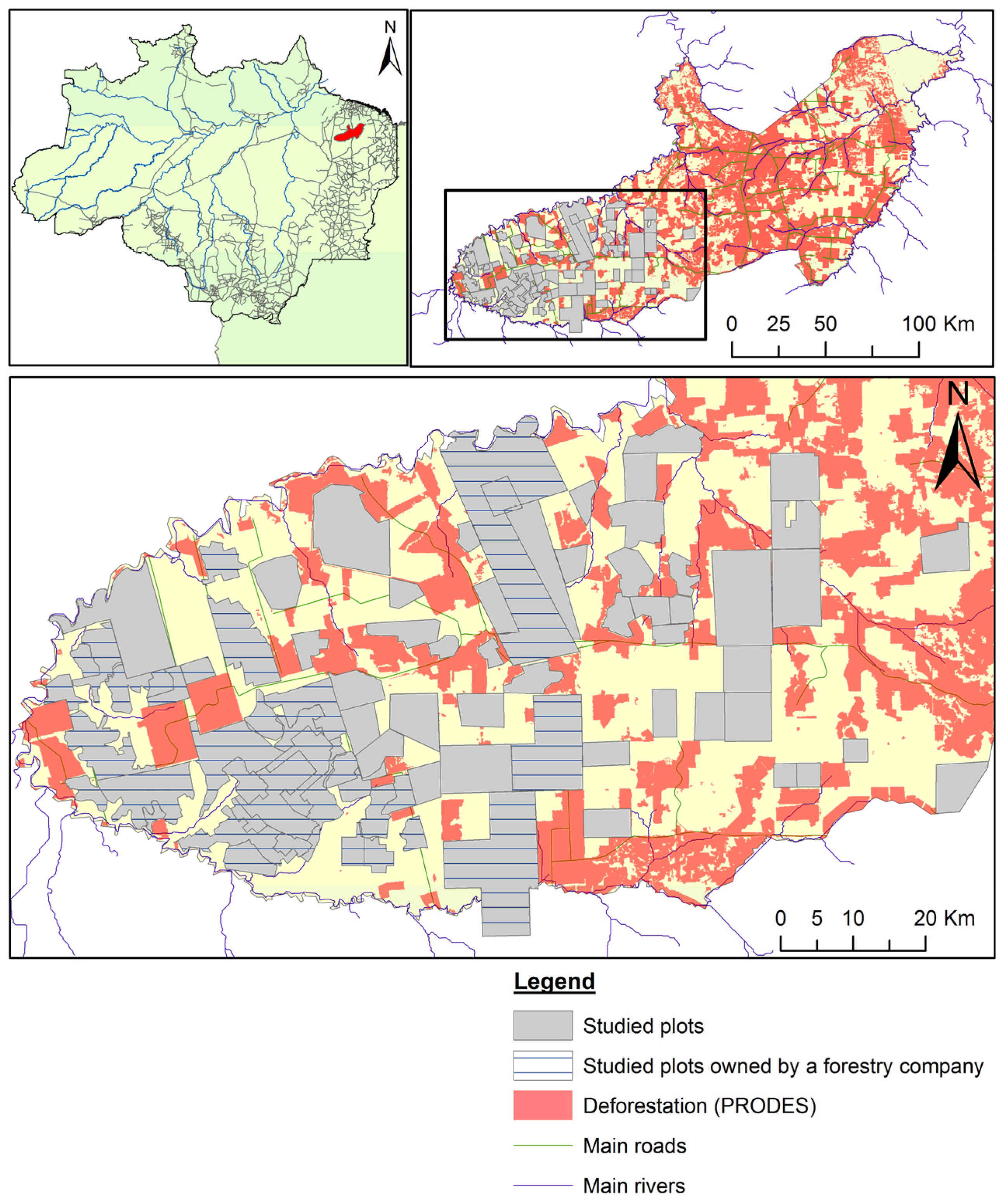
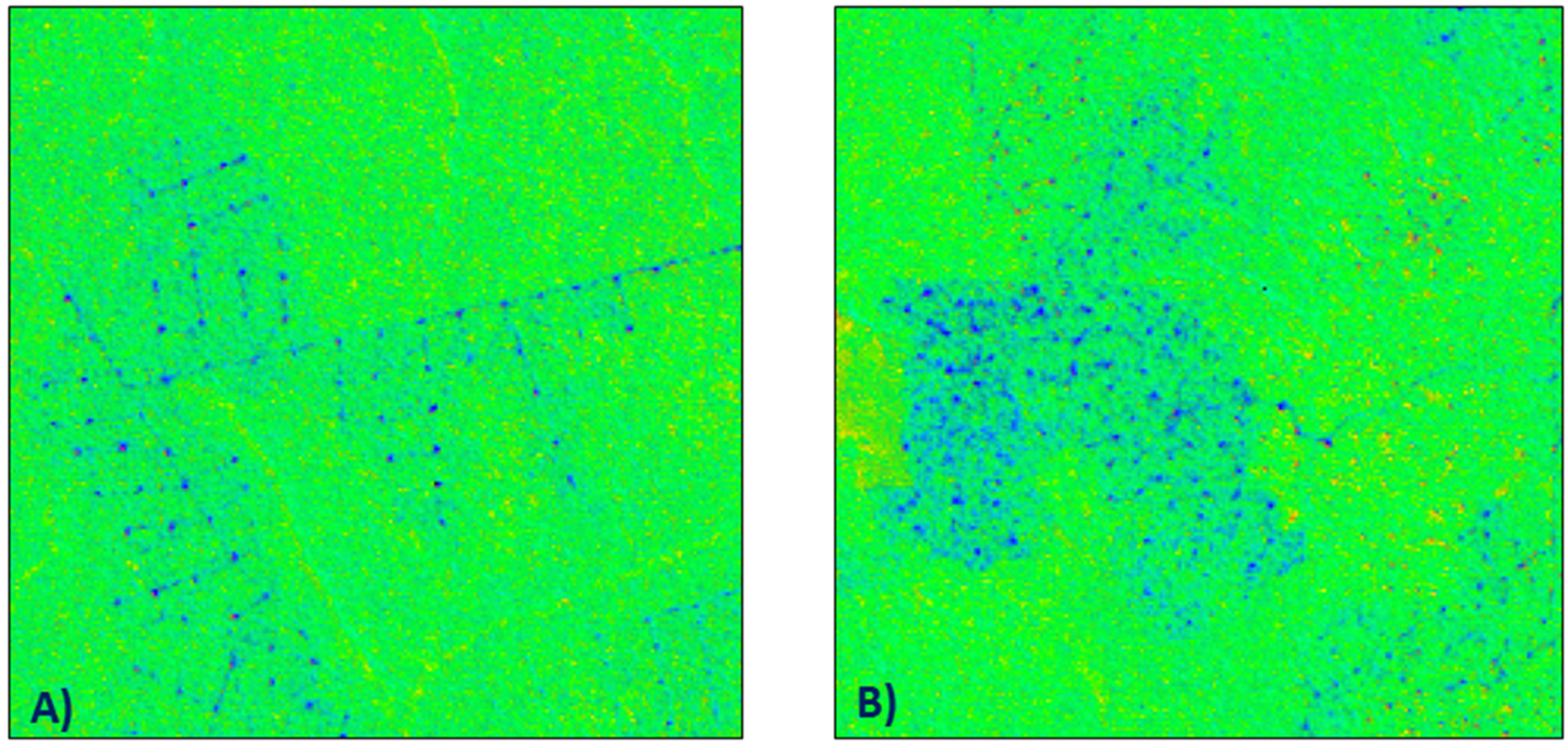
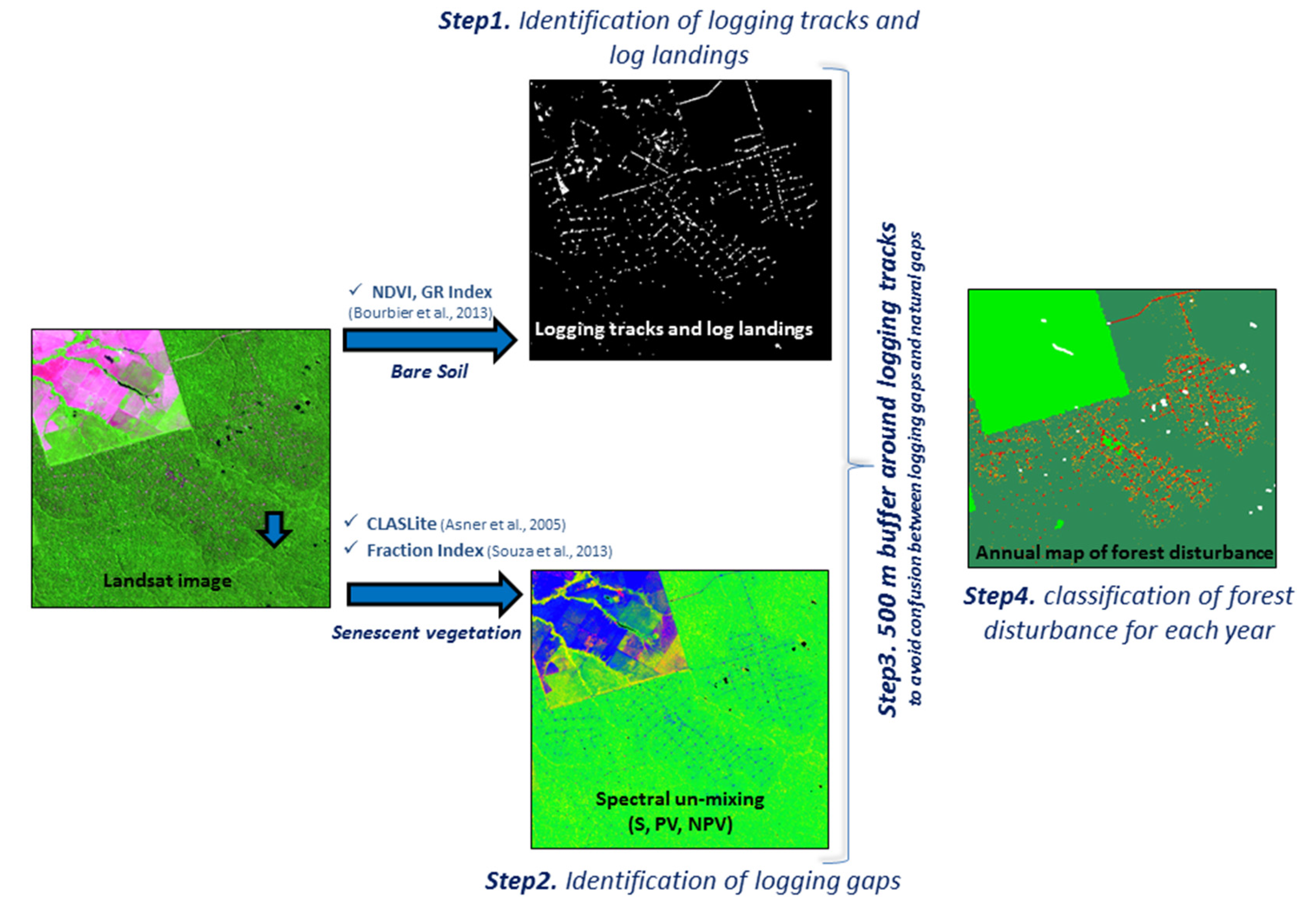
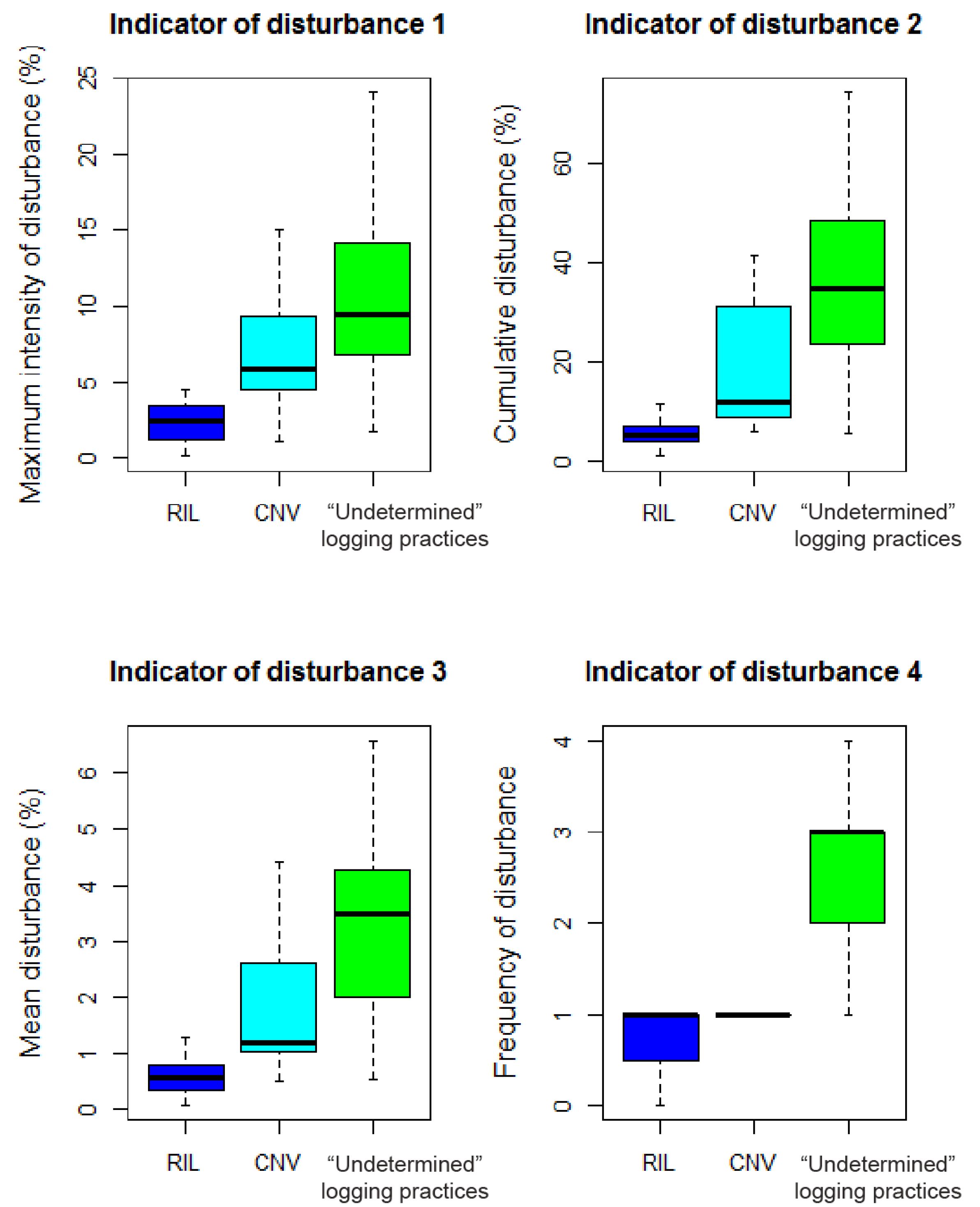
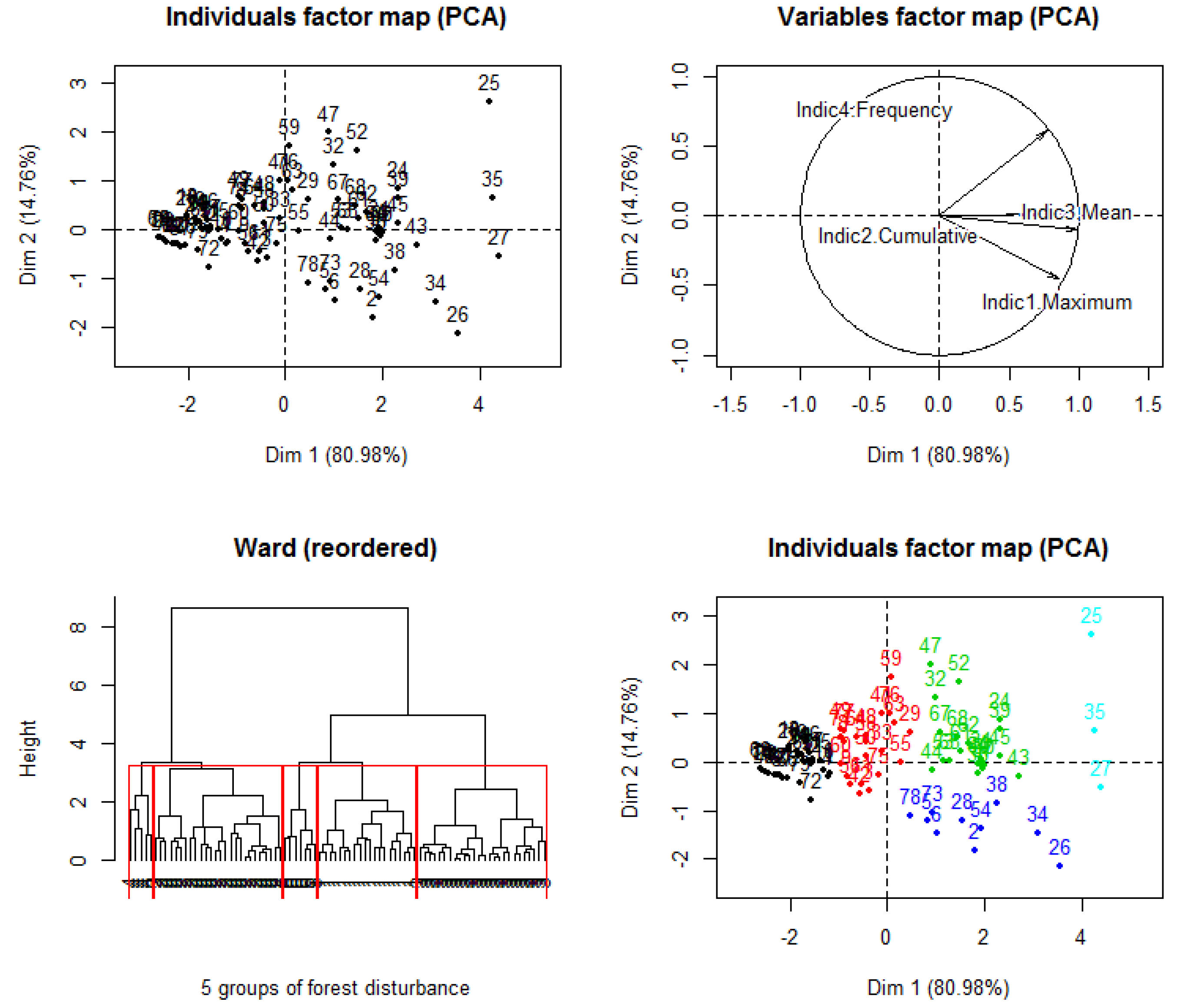
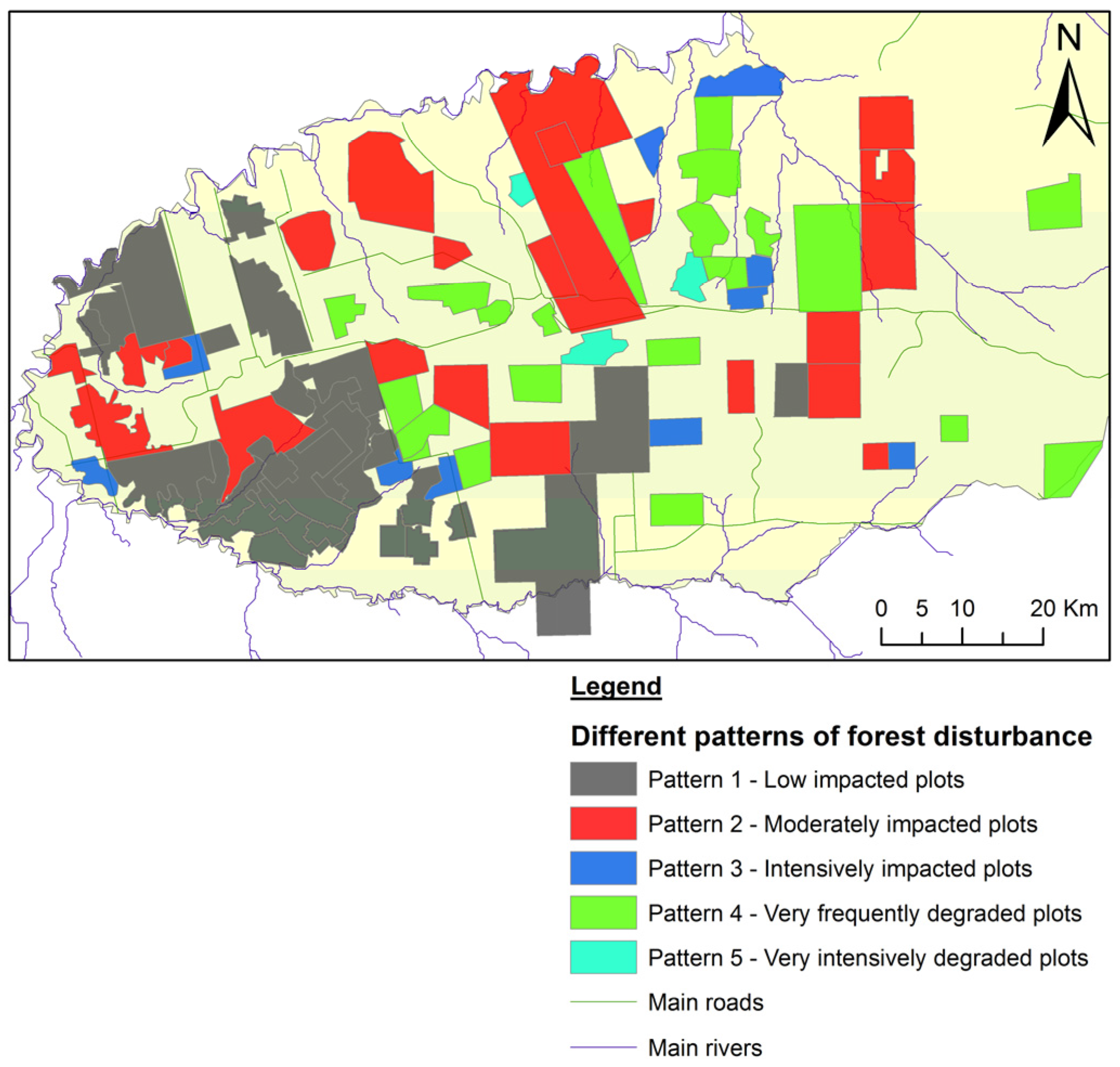
© 2016 by the authors; licensee MDPI, Basel, Switzerland. This article is an open access article distributed under the terms and conditions of the Creative Commons Attribution (CC-BY) license (http://creativecommons.org/licenses/by/4.0/).
Share and Cite
Tritsch, I.; Sist, P.; Narvaes, I.D.S.; Mazzei, L.; Blanc, L.; Bourgoin, C.; Cornu, G.; Gond, V. Multiple Patterns of Forest Disturbance and Logging Shape Forest Landscapes in Paragominas, Brazil. Forests 2016, 7, 315. https://doi.org/10.3390/f7120315
Tritsch I, Sist P, Narvaes IDS, Mazzei L, Blanc L, Bourgoin C, Cornu G, Gond V. Multiple Patterns of Forest Disturbance and Logging Shape Forest Landscapes in Paragominas, Brazil. Forests. 2016; 7(12):315. https://doi.org/10.3390/f7120315
Chicago/Turabian StyleTritsch, Isabelle, Plinio Sist, Igor Da Silva Narvaes, Lucas Mazzei, Lilian Blanc, Clément Bourgoin, Guillaume Cornu, and Valery Gond. 2016. "Multiple Patterns of Forest Disturbance and Logging Shape Forest Landscapes in Paragominas, Brazil" Forests 7, no. 12: 315. https://doi.org/10.3390/f7120315
APA StyleTritsch, I., Sist, P., Narvaes, I. D. S., Mazzei, L., Blanc, L., Bourgoin, C., Cornu, G., & Gond, V. (2016). Multiple Patterns of Forest Disturbance and Logging Shape Forest Landscapes in Paragominas, Brazil. Forests, 7(12), 315. https://doi.org/10.3390/f7120315






